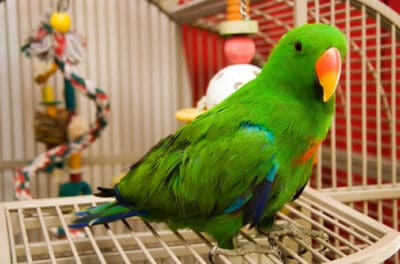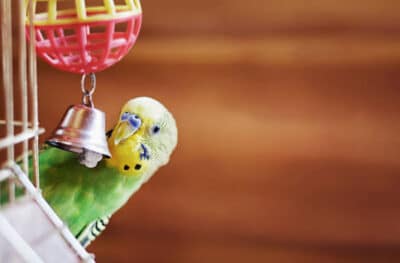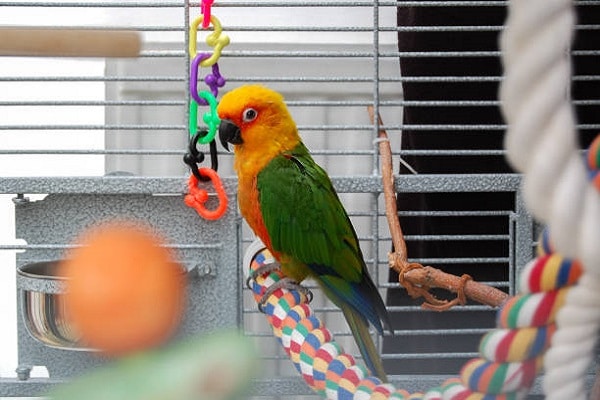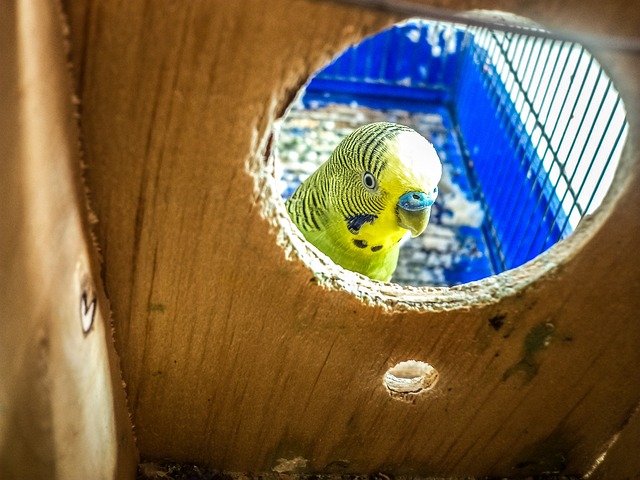Whether you’re welcoming a parakeet into your home because your kids really wanted one, or you’ve been lusting after a colorful parrot because you’ve always wanted a pet bird that can talk, expect to be entertained by the bird you adopt the moment that cage crosses your threshold.
These winged creatures may be exotic, but even the smallest species deserves the best pet bird care you can afford him. This guide will help you do that. Whether you’ve got your heart set on one Cockatoo or you can’t resist a pair of lovebirds, you’re going find your new pet(s) lovable and entertaining!
What do you need for proper pet bird care?

The first and most obvious thing to consider for your pet bird is the cage and perches. Cage size and perch bar placement are both important to your new bird’s comfort and well-being. Whether you’re keeping a canary or your new best bird is a Macaw, understand that the cage you choose must give your bird plenty of room to spread out and feel at home.
The larger the bird, the more wingspread space he needs, so if you choose a large bird with an equally long tail, the cage you pick can’t be too tall if you want your bird to avoid injuring his tail feathers. In general, your mantra should be “The larger the better” since your bird will spend a major amount of time there.
Must you clean out your 401K account to equip your cage? Definitely not, but you’ll need some basic items to make sure you have the proper pet bird care items. If perches don’t come with the cage you select, attach dowels or tree branches to the cage interior, and hold them in place with coated wire. Most cages do come with perches, so this shouldn’t be a problem.
The next items you need to ensure you have are food and water dishes. Again, most cages come with these items but there are multiple options that might work better for your pet bird if you look online.
Even small birds need some privacy, so tuck a nesting box or a makeshift hideaway into the cage so when he shows signs of being overly excited, he’ll have somewhere to hide until things quiet down.
What pet doesn’t love toys that amuse and entertain? You probably won’t have trouble finding toys at your local pet store, though you’ll likely find a wider range of products online. That stated, don’t go overboard and fill his cage with so much stuff, he’s got no room to navigate.
What belongs on your bird’s dinner menu?

Like humans, one guy’s Big Mac is another one’s vegan plate, so it should come as no surprise that bird species have their own dietary preferences, too. While you can generalize in terms of primary diets that include seeds and fruits for nearly every bird type, there are dietary guidelines that are breed-specific.
While you’re browsing the Internet looking for toys, you may wish to consult bird nutrition sites that recommend certain types of bird foods or consult the folks at the retailer you patronize to get their recommendations.
All birds require fresh water on a daily basis. Stagnant water can turn a bird’s water dish into a Petri dish filled with bacteria, so you’ll want to change your birds water daily sure your bird doesn’t sick. It is often cautioned to give birds well water because it may contain hard minerals that can impact a bird’s kidney function.
Finally, if your diet gets boring, imagine how a bird feels when fed a steady diet of seed! Supplementing birdseed with a pelleted diet formulated for birds plus small amounts of fruit are a great way to flesh out your bird’s diet, but don’t overdo the fruits since they offer birds relatively few nutrients, amino acids, and vitamins.
Pet Bird Cage Cleaning 101

There’s no avoiding cleaning your bird’s cage and the larger your bird the more often you will probably want to do the job. We recommend weekly cleanings for large birds and bi-monthly cleanings for small ones. That being said, the condition of the cage’s interior should always determine whether cleaning is needed. Our step-by-step recommendations for cage cleaning will get you into a routine before you know it.
- Amass cage cleaning supplies: a soft cloth and brush plus any of the cage-cleaning disinfectants formulated for bird cages on today’s market. Want to make your own? Try mixing 2 Tbsp. lemon juice, 3 Tbsp. baking soda and 3 cups of hot water in a spray bottle to make an earth-friendly cleaning solution. Disposable gloves for your hands are also recommended.
- Once Tinkerbell has been released from her cage, dust and wipe off all interior surfaces and then wipe everything down with the cleaning solution you’ve chosen to disinfect the cage.
- Pay special attention to scouring bottom trays, perches, feeding, and water vessels. Dry all areas and line the cage bottom with newspaper or a commercial cage liner.
- Cage liners are indispensable when the time comes to refresh your bird’s cage and if you use sheets of newspaper to do the job, you’ll cut back on the amount of time you spend scouring the bottom of the cage. If you’re in a pinch, Glad Press n’ Seal Wrap makes a great cage floor liner substitute.
- Did you know that handheld steam cleaners usually employed for cleaning upholstery make great birdcage steamers to up the standard of your pet bird care cleaning ritual? The concentrated steam gets into corners even brushes miss and because of the pressure, cages dry faster, too.
How can you tell if your bird is sick?
You don’t have to have a degree in avian medicine to learn to figure out whether your bird is out of sorts, but to deliver the best pet bird care, it’s helpful to know a little about bird biology! In the wild, birds do an awesome job of hiding ailments, symptoms, and illnesses because if they’re perceived as being weak, they could be shunned by other birds.
Because all species of birds exhibit this instinctive behavior, by the time you notice that something is wrong, your pet may have been ill for some time, so if his habits or behavior changes, a phone call to your vet describing those changes is a wise move.
Even if you stay on top of cleaning and hygiene practices related to your bird, you may still not be able to prevent him from becoming ill. Causes can be genetics, stress or trauma, over which you may have little to no control.
That stated, once you get to know your bird’s habits and behaviors, you’ll be able to tell that something’s off — especially if Tweety’s food holder goes untouched or he’s not drinking his usual amount of water.
5 tips for welcoming your new bird

- If your newcomer isn’t the first bird in your aviary, don’t introduce Birdie to your existing birds until he has been quarantined for what the AVMA calls “an appropriate length of time” best determined by a vet. Give the newbie his own space until your vet says it’s time to introduce him to his new BFFs (that’s Bird Family and Friends).
- Don’t wait until the day you are scheduled to pick up your bird to set up his space and don’t make abrupt changes to his diet until he has settled in or you could traumatize him. Ask pet store staff what they’ve been feeding him so there’s as little interruption in his routine as possible while he transitions to his new home.
- Birds of all sizes and species do best when they’re given access to space that enables them to walk around, climb and fly outside the cage. The AVMA recommends several hours of freedom daily because your bird won’t thrive if he spends all of his time caged. Birds appreciate cages stationed or hung at eye level or higher because it makes them feel safer.
- Check the vents and windows in proximity to the place you’ve selected for cage placement to make sure there are no drafts that could cause your new bird to fall ill. Additionally, keep him away from potential contact with cleaning fumes and odors that could stress out his respiratory system.
- Perch type and installation can make or break your bird’s cage experience. Those dowels, branches, and other bars designed for perching should be sized to accommodate your bird’s feet and “provide good footing.” How would you like to be handed a pair of size 9 shoes when you wear a size 10?
Which pet bird is your family’s best fit?
Adopting a bird is going to change the way your household runs, so understanding which type of bird is right for your household can make or break the relationship. Start by doing a little research on different types of pet birds and then ask yourself these questions before you shop.
Q: I want a bird but I don’t like cage cleaning.
A: You can’t avoid all of it, but budgies, canaries, finches, lovebirds and other small birds are your best bet.
Q: I don’t have very much space at home? Can I still get a bird?
A: As long as the cage you choose offers your bird the right environment and he gets out daily, you’ll be fine.
Q: My neighbors live close by. I understand that some birds shriek like banshees. What’s my best recourse?
A: Take a pass on birds in the cockatoo, parrot, and conure families. Proper pet bird care begins by choosing a bird you can enjoy without starting neighborhood feuds.
Q: How can I make sure a new bird will get along with my other pets and my kids?
A: Choose a gentle breed, keep the cage as high as possible off the floor and until you watch everyone in the household engage with the bird, adult supervision is always a good idea when the bird isn’t caged.
Q: I have a disability and I would love a companion bird. Is this feasible?
A: As long as your doctor approves of the adoption you should be fine, just as long as your illness doesn’t prohibit you from tasks associated with cleaning out the cage.
Q: What if my bird bites me?
A: Choose a smaller bird, like a cockatiel, since larger, more powerful birds are more likely to get aggressive as they mature. Nobody wants to be on the receiving end of a nip delivered by a strong beak!
Q: A guy is selling captured wild birds for much less than I would spend at a pet store. Should I buy one?
A: The answer is a resounding no. Not only does the Wild Bird Conservation Act of 1992 make trafficking illegal but you don’t know what diseases or illnesses those birds could be carrying.
Q: How long does it take to bond with a bird?
A: Unweaned birds bond faster because feeding them by hand promotes closer ties. That doesn’t mean your weaned bird won’t bond fairly quickly when he’s shown lots of love.
Q: I want to adopt a bird rather than buy from a breeder. Got any advice?
A: Meet the current owner so you can find out if the bird has any pre-existing problems or issues and get your hands on vet records that exist. Alternately, go through a reputable bird rescue group in your area.
Q: Which bird(s) can talk back to me?
A: African Gray and Amazon parrots are the best talkers but not all them talk. Sometimes, it’s the owner’s fault. “Birds who speak the most are those who are spoken to most often,” says Dr. Krinsley. But be careful what you wish for if you like to sleep late in the morning and your new pal has other ideas!




